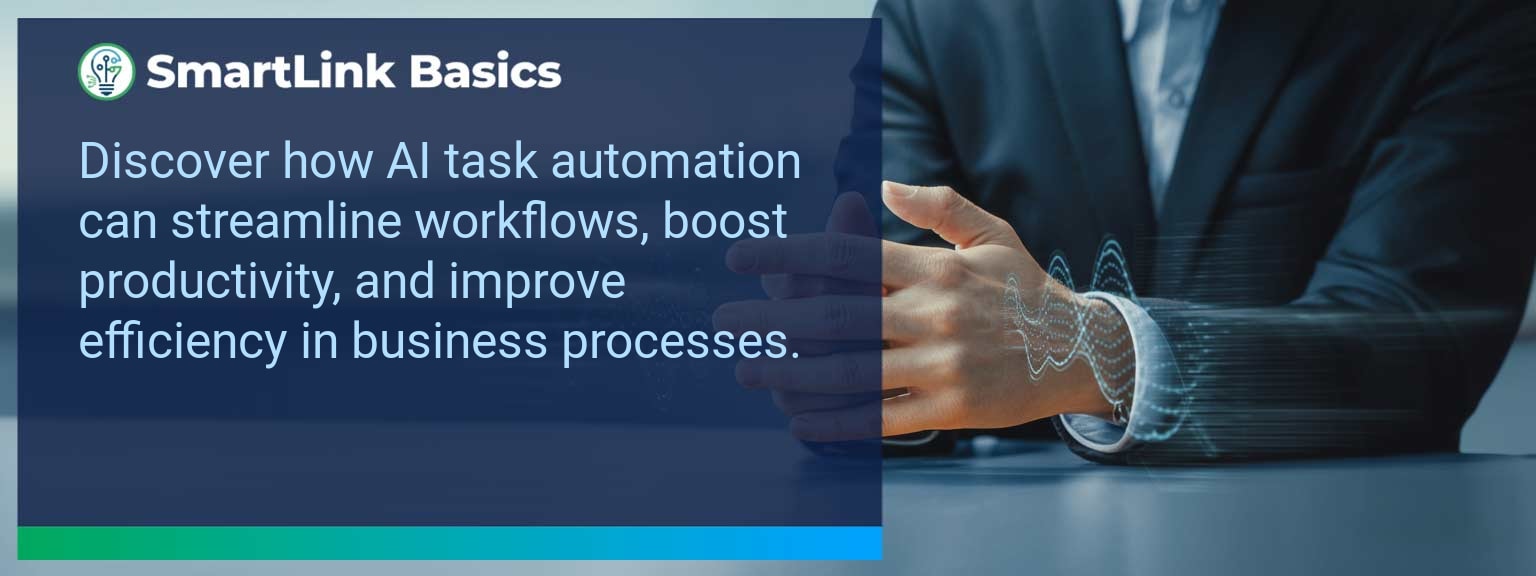McKinsey research shows that AI can automate up to 45% of workplace tasks, unlocking capacity for higher-value strategic work. For sales leaders, this shift has immediate implications: every manual process that slows deal velocity is an opportunity cost. SmartLink Basics works at the intersection of AI productivity and revenue operations to help decision-makers streamline high-impact workflows.
In this article, we focus on how AI task automation dramatically improves accuracy, efficiency, and speed in sales and operations. You will see exactly where bottlenecks form, how AI workflow solutions address them, the tangible performance results to expect, and why now is the critical adoption window. By the end, you’ll have a clear roadmap for deploying automation software in ways that amplify business efficiency and revenue impact.
- Identify repetitive, high-frequency tasks suitable for AI automation.
- Integrate workflow automation tools into existing sales processes.
- Leverage machine learning for data entry, lead scoring, and forecasting.
- Measure ROI through time savings, conversion rates, and cost reductions.
- Scale AI applications across departments after pilot success.
What Changed and Why AI Task Automation Matters Now
The acceleration of digital transformation has reached a point where manual sales operations are a competitive liability. AI task automation consolidates fragmented processes, removes repetitive work, and delivers operational insights in real-time. Sales teams managing high lead volumes and complex touchpoints face performance drag when dependent on manual processes. For example, a mid-market SaaS team using AI-driven CRM data enrichment reduced lead qualification time by 60% in one quarter. The clear takeaway: adopting automation software now positions your team to capture gains ahead of the next adoption curve.Redesign the Revenue Operating System With AI Task Automation
To embed lasting productivity gains, AI adoption should extend beyond one-off tool integration into a complete operating model redesign. ICP, Segmentation, and Targeting AI workflow solutions refine targeting by analyzing buyer personas and engagement history at scale. This data guides precision outreach rather than blanket campaigns. Pipeline Architecture Automation ensures leads are routed, scored, and prioritized instantly, eliminating lag between interest and action. Plays and Messaging Workflow automation tools can trigger sequencing and personalize messaging dynamically based on buyer behavior. Operating Cadence Real-time dashboards aggregate machine learning automation insights, supporting fast, informed decision-making. The practical step: start with one high-impact process and integrate AI-driven productivity tools there. Validate performance, then expand.Common Workflow Inefficiencies Hindering Productivity
Disorganized lead management, duplicated tasks, and slow reporting all contribute to revenue leakage. Without automation software, teams often spend more time on administration than selling. Consider a national B2B distributor: sales reps were manually compiling pricing sheets, leading to delays and errors in quotes. After moving to templated, automated quoting, quote turnaround improved from 72 hours to under 8. To counteract inefficiencies, map each process, pinpoint repetitive steps, and flag them for automation.How AI Task Automation Addresses Workflow Problems
AI task automation minimizes manual errors, accelerates process completion, and enables instant data synchronization across systems. By embedding workflow automation tools into daily operations, leaders create a self-optimizing environment where productivity compounds. An inside sales team using predictive lead scoring, fed by machine learning automation, reported a 22% increase in qualified pipeline within 60 days. The insight here: AI not only accelerates execution but improves the quality of decision-making.Tangible Benefits Seen After Implementing AI
After integrating AI workflow solutions, leaders report immediate wins: faster lead handling, higher conversion, and reduced workload on high-value staff. Over time, automation reduces operational costs while increasing output. Example: A financial services firm deployed AI-powered meeting scheduling, freeing high-performing reps from calendar coordination. The result: additional client meetings per week, without extending work hours. Focus your KPI tracking on both time-based and revenue-based metrics to prove sustained value.The Growing Role Of AI In Future Workflows
AI will soon shift from enhancing productivity to predicting and initiating tasks without human prompts. As integrations deepen, business efficiency will hinge on orchestration across multiple automation platforms. Sales leaders who start with targeted implementations now will be best positioned to lead in this predictive, fully integrated future.| Category | Metric | Definition | Target |
|---|---|---|---|
| Leading | Automated Task Completion Rate | Percentage of tasks executed without manual intervention | 85%+ |
| Leading | Workflow Integration Coverage | Number of core processes with AI integration | 6+ |
| Lagging | Conversion Rate | Opportunities won ÷ total qualified leads | 30%+ |
| Lagging | Cycle Time Reduction | Decrease in average sales cycle length post-AI adoption | -20% or more |
| Quality | Data Accuracy Index | Accuracy rate of CRM and operational data after automation | 98%+ |
| Quality | User Adoption Score | Percentage of team actively engaging with AI tools | 90%+ |
Get the 90-day plan, coaching rubric, and dashboard template to operationalize AI in your enablement program.









